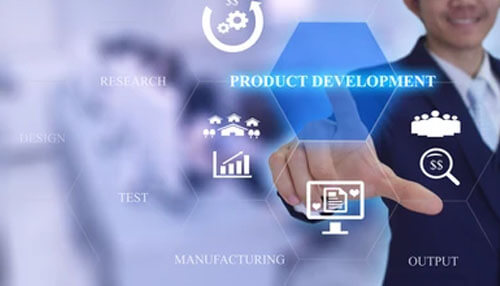The truth is customers and markets are evolving continuously. Old service standards might not respond properly to changing expectations while new ones might enter the game. It is quite obvious that software solutions and products will not be static. Rather, adoptions will be necessary to retain market leadership and to be at par with multiple market changes! Hence, the product development life cycle process has to take into account all such changes. The entire organization needs to be better prepared to implement its strategy changes early on. Hence, the productive development life cycle process is carried out in a multi-step algorithm and not in just a single go!
Main Stages Involved In Product Development Life Cycle
Successful companies in thousands are found to use the commonly availed ‘7-step model’.
1. Idea generation:
It is tough to identify and schedule the products to be developed. It is rather a time to get your business concept validated properly. At the same time, it is necessary to observe your target audience, do market research, and make remarks about current projects. You can try some time-proven techniques to develop creative concepts. It includes Mind-Mapping, SCAMPER, Crowdsourcing, Scientific Materials, etc.
2. Idea Screening:
After generating ideas, the next step is to test the concepts. Ensure they survive long-term. During this stage, you need to have 5-10 ideas at the minimum to derive freedom of choice. Idea screening helps cut off those concepts that fail to align with market trends, user needs, and company values or do not attract potential investors. This is indeed a vital stage to ensure product success.
3. Concept Testing in Product Development Life Cycle
Generating five prototypes will involve a good amount of money. So perform budget analysis. Hence, narrow choices to about 1-2 options. Avoiding concept testing as well as rushing to development straight away is a major mistake. This stage requires proper product description of how customers would like to view and use it. This information is to be demonstrated to potential customers. An effective version will be to generate the least viable product having limited functionality. It should exhibit the primary purpose clearly.
4. Product development:
In case the idea is found to have commercial potential, then get your development team to execute it. The marketing department and software development team are to work together to cope with multiple market changes. This will ensure meeting set financial goals and ensure tangible business. But before developing product code, understand product price, break-even number, potential lifespan, and expected sales amount.
5. Testing and Execution:
Software testers and Quality assurance specialists are to be part of the project much early on. They should establish code quality standards, track mistakes, do budget analysis, etc. Being responsible from the early stage assures enhanced final performance. Early integration testing offers quality marketing solutions, reduced feedback loops as well as enhanced product quality.
6. Post-Development:
Once the product’s basic version gets created and tested, it is to be offered to first users, referred to as ‘Beta-Testing’. It is done to enhance interface, functionality and to prepare solution meant for actual launch. Product success depends mostly on settings, release timing and meeting target audience.
7. Support and Maintenance in Product Development Life Cycle:
After launching the product, the product development life cycle should be maintained to evolve it constantly. It will be necessary to identify ways and means to enhance its efficiency, performance speed, quality, etc. It also includes reaching new audiences as well as increasing existing user loyalty. Product success should be analyzed to mea\sure user numbers, evaluate client reviews and social media.
The fact is product development life cycle is undoubtedly an ongoing process. It needs constant research, monitoring, creativity, and improvement. User priorities tend to change soon. Hence, get to know your users, collect feedback, follow market trends for new ideas.



